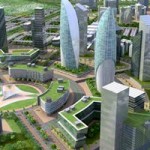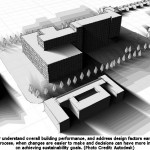
SAN FRANCISCO – IBM has added new software and services to its expanding portfolio of solutions aimed at creating sustainable enterprises and smarter urban infrastructures. The new offerings, piloted in-house by IBM, help owners and managers of commercial buildings leverage the latest efficiency technologies and compliance systems to deliver economic, operational and environmental benefits.
IBM also announced that Autodesk has joined its industry alliance, Green Sigma Coalition, a move that can help the group improve buildings’ sustainability from blueprints to daily operations.
Additionally, IBM announced an expanded relationship with Schneider Electric, global specialist in energy management, to deliver new combined offerings that monitor and reduce energy use to make buildings smarter.

IBM, Burlington, Vermont – IBM’s new Sustainability Management System is a home-grown solution piloted in house. SMS technology allowed IBM’s semiconductor factory in Burlington, Vt., to slash water usage – a key ingredient in chip making – by 29% from 1990 to 2000, while manufacturing capacity at the plant rose more than 30%.
IBM’s expanding partner ecosystem allows the company to continually extend the reach of open-standards and analytics and automation software such as Maximo Asset Management. Real-time data is collected by the building-management systems provided by such companies as Schneider Electric, Johnson Controls, Honeywell/Tridium and Eaton. IBM software analyzes the data to enable real-time improvements in operations, a critical process – while 85% of global companies have sustainability programs, only 30% collect data frequently enough to improve operations.
New Technology Based on in-House Results
The new IBM solutions help customers manage, operate and optimize new IT systems that offer end-to-end control of enterprise sustainability. Highlights include:
- Smarter Building Solution: IBM is installing its first customer-ready smarter building solution at its headquarters in Armonk, New York and its manufacturing facility in Rochester, Minnesota. The solution, implemented with Johnson Controls, connects information from the building management system, site electrical meters, the Maximo asset management system, and external sources such as weather data. The system provides a significant increase in the level of building operational intelligence. Advanced analytic tools add intelligence to provide operators with new information on energy consumption, operations and space usage; showing how and where to save money. A dashboard based on IBM Mashup Center provides real-time visibility into this advanced management technology. The IBM Smarter Building solution links with leading building-management systems such as the ones provided by Johnson Controls, Tridium and Schneider Electric.
- IBM Maximo Asset Management for Energy Optimization 7.1.1 collects and displays a data center’s energy and environmental data including temperature, humidity and power usage. It helps reduce costs and risks by generating a thermal map of the environment. This data-driven, graphical view indicates where temperatures are too low, for example, pointing to an opportunity to use less air conditioning. It also merges temperature and humidity information with data about equipment and other assets to update preventive maintenance schedules.
- Myincentivefinder automates the process of navigating the forms and processes needed to earn incentives that can reward energy-efficiency upgrades by facilities managers or IT managers.
- A new services offering – the IBM Sustainability Management System, based on IBM best practices, integrates sustainability efforts with business strategies to help make sustainability a cornerstone of corporate operations.
The IBM Sustainability Management System – like many of the company’s new sustainability offerings – is a home-grown solution developed in concert with an ongoing internal program to manage IBM’s environmental responsibility in a systemic way as a strategic imperative, setting goals and achieving measurable results. At its semiconductor factory in Vermont, for example, IBM reduced water usage – a key ingredient in chip making — by 29% from 1990 to 2000, while manufacturing capacity at the plant rose more than 30%. IBM has saved 5.1 billion kilowatt-hours of electricity between 1990 and 2009 and avoided associated 3.4 million tons of CO2 emission. Last year, 76 percent of the company’s hazardous waste was sent to recycling.
New IBM software creates a thermal map of data center and facilities assets to enable quicker responses to hot spots or over-cooled areas. The analytics in the software help companies evaluate the utilization of each air conditioning unit, for example, to shut down ones with low utilization to let the nearby units handle the load. Pictured above is Maximo Asset Management for Energy Optimization 7.1.1.
“Today’s announcements are about using IT to integrate buildings and their operations with the natural and societal systems around them to create smarter urban infrastructure,” said Rich Lechner, Vice President Energy & Environment at IBM. “Sustainability calls for applying information in new ways to benefit the economic, environmental and operational strategies of an organization.”
IBM Project to Demo Smart Building Connecting to Smart Grid
To demonstrate technologies that can allow smarter buildings to plug into renewable energy sources and smart grids, IBM is announcing that it plans to work with Eaton Corp. and NC State University to create a working model of such a home at The Future Renewable Electric Energy Delivery and Management (FREEDM) Systems Center in Raleigh, N.C. The center, funded by the National Science Foundation (NSF), focuses on developing technologies for the “last mile” of the utility grid, enabling energy generation, storage, and intelligent use of energy to be delivered curb side.
IBM’s work with the FREEDM center joins a growing list of high-profile R&D projects the company has recently undertaken to develop new IT applications for buildings and infrastructure. The Energy Innovation Hub at the Philadelphia Navy Yard, and a new pilot program with New York City are the latest examples of IBM R&D being applied to solve issues in creating sustainable urban infrastructure.
Source: IBM.







